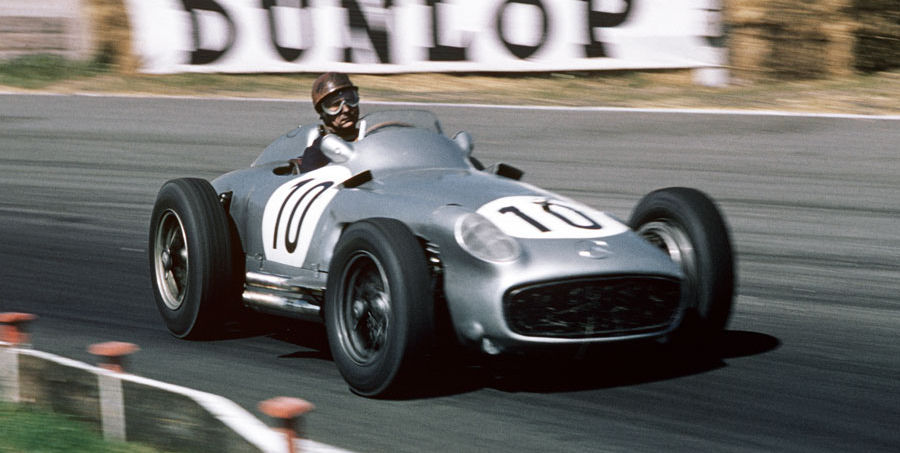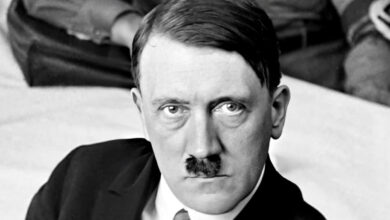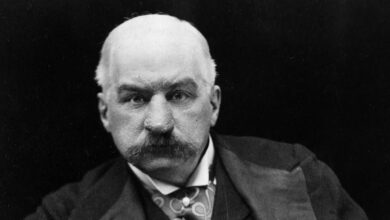
Podcast: Play in new window | Download
Subscribe: Spotify | Amazon Music | Youtube Music | RSS
“A crazy man finished in the cemetery.” – Juan Manuel Fangio
Although motor racing in its various forms has been around since very soon after the invention of the motor car, for most motorsport enthusiasts if you were to ask them what the pinnacle of the sport is on the world stage, it is likely that a significant percentage would say Formula One.
The FIA Formula One World Championship as it is now known was inaugurated in 1950 and during the first decade of its existence, it was dominated by one man, who by 1957 had won no less than five world championships, a record which stood until Michael Schumacher came along and beat it 46 years later. Many consider him to be one of the greatest F1 drivers in history. He was Argentinian and his name was Juan Manuel Fangio.
Fangio was a third-generation Italian immigrant and was born in a city in Buenos Aires Province called San Jose de Balcarce, which is often shortened to just Balcarce, on 24 June 1911. He had five siblings, three older, and two younger and he became known for his football skills as a child and possessed a seemingly magical ability to wrap his leg around a ball as he took shots on goal, a skill which led to him receiving the nickname El Chueco or the bandy-legged one.
Fangio first attended School No. 4 in Balcarce and then School No. 1 before dropping out at the age of 13 to get a job, becoming an assistant auto mechanic at the workshop of Miguel Ángel Casas.
Following a bout of pneumonia when he was 21, he spent a year doing his military service, commonly called “La Colimba” as in “corré, limpié, barré” (run, clean and swipe), and following his discharge on his 22nd birthday Fangio returned to Balcarce with the intent of making a career for himself as a footballer. However, at the suggestion of some teammates, he and his friend José Duffard turned their attention to building their own car with Fangio’s parents making space for him to do so in a shed at the family home.
Soon afterwards, Fangio opened his own garage and raced with Duffard in a local event in 1937 called La Chata, driving a Buick, but he failed to finish. In March the following year, he raced at the Necochea circuit driving a Ford V8 and fared better, finishing 7th.
Having been involved in the Turismo Carretera racing series in 1938 as a co-driver to Luis Finachietti, Fangio entered the 1939 series as a driver, driving a Chevrolet Coupe. One of the races was dubbed El Gran Premio Argentino (The Argentine Grand Prix), but a huge storm caused it to be abandoned.
In 1940, Fangio entered the Turismo Carretera again and this time he won one of the two races and made the podium in the other, allowing him to accumulate enough points to win the title. He successfully defended the title in 1941 winning both races in the series. This was no mean feat as although the racing series, which incidentally is the oldest motor racing series to still be active, now exclusively takes place on closed circuits, in Fangio’s time it consisted of road races, some of which could be gruelling with distances of up to 10,000km being covered in often atrocious conditions and on terrible roads. For example, the 1940 race was 9500km long. It started in Argentina, ended in Peru and passed through Bolivia on the way.
Following the Second World War, Fangio immediately returned to racing, having numerous successes over the next couple of years. He entered his first event in Europe in an F1 race at the French Grand Prix in Reims in July 1948, driving a Simca-Gordini but unfortunately had to retire with mechanical trouble.
However, on returning to Argentina, Fangio’s life and career were struck by tragedy when on the tenth day of a 20-day point-to-point motor racing event between Buenos Aires and Caracas, Venezuela in October 1948, during a night-time stage along the Pacific Ocean coastal road in Peru, Fangio, driving in thick fog, crashed down an embankment. Fangio was injured, but his co-driver Daniel Urrutia was killed.
Initially believing he would never race again, Fangio recovered remarkably quickly and what’s more, it turned out that the Argentine Automobile Club, as well as the Argentine government, had taken notice of his driving successes. They presented him with a Maserati and asked him to return to Europe to pursue his motor-racing career driving for his country. Fangio accepted, and only two months after his crash was on his way back to Europe.
By the time he started his Grand Prix career, Fangio at 31 was one of the oldest drivers in the field, but the physically demanding nature of Formula One racing did not seem to faze him. He entered the San Remo Grand Prix in 1949 and dominated the race, winning by almost a minute. He went on to enter another six Grand Prix races that year and won four of them.
1950 was the inaugural year of the World Championship of Drivers and Fangio had joined the Alfa Romeo team, winning three races at Monaco, Spa and Reims but failed to win the title as his team-mate Giuseppe Farina fared slightly better in the other four races on the calendar.
However, it was a different story in 1951, as Fangio won the Drivers Championship for the first time, again winning three races in Switzerland, France and Spain, but finishing six points clear of Ascari due to the new 4.5 litre Ferraris taking points off Farina and others in the other races.
Alfa Romeo did not compete in the 1952 championship due to rule changes leaving them with noncompliant cars. This left Fangio without a seat and he didn’t race until June. Even then, it was in a non-championship F1 race driving a BRM in France and Northern Ireland. He had also agreed to drive a Maserati in a non-championship race at Monza but missed his connecting flight from Northern Ireland. Consequently, Fangio made the fateful decision to drive through the night and arrived at the circuit only half an hour before the start of the race. Due to being massively fatigued, Fangio crashed and was thrown from the car. He was taken to hospital with multiple injuries, including a broken neck and spent the rest of 1952 recovering.
Back to racing fitness, he finished second in the 1953 championship driving a Maserati. He continued with Maserati in 1954, winning both his home Grand Prix in Buenos Aires and the Belgian Grand Prix at Spa in the legendary Maserati 250F, but switched mid-season to Mercedes-Benz when the German team joined the F1 fold. He won the first race that Mercedes-Benz competed in at Reims and went on to win six of the eight drivers championship races, taking his second world championship in the process.
Fangio won his third world title in 1955 driving for Mercedes but that season was marred by the death of 80 spectators and the French driver Pierre Levegh at Le Mans following an accident which also left more than 180 people injured. The tragedy, which happened right in front of Fangio and nearly killed him, prompted Mercedes to retire from motor racing with the German manufacturer not returning to the sport until 1989.
Fangio moved to Ferrari for the 1956 championship and despite not getting on too well with Enzo Ferrari himself, he won his fourth title driving a Ferrari-prepared Lancia, winning the Argentinian, British and German Grand Prix along the way. The following year, Fangio claimed his fifth and final world title after moving back to Maserati and retired from racing following the 1958 French Grand Prix, simply saying to his mechanic, “It is finished”.
Juan Manuel Fangio’s five world drivers’ championships (and two second places) came whilst driving for four different teams, Alfa Romeo, Ferrari, Mercedes-Benz and Maserati, and although the record for the total number of world championships won by one man has since been beaten, the record for winning it with more than one team, has not.
He entered 52 F1 races and won 24 of them, a win rate that has not been matched.
Fangio is also the only Argentinian driver to win the Argentine Grand Prix, a race which he has won more than any other driver, taking the chequered flag four times during his career. And when he won the 1957 driver’s championship, he became the oldest man ever to do so at 46 years and 41 days.
After retiring from motorsport, he sold Mercedes-Benz cars in Argentina and went on to become the honorary president of Mercedes-Benz Argentina in 1987.
He was inducted into the International Motorsports Hall of Fame in 1990.
In 1982 Fangio suffered a heart attack but made a good recovery following surgery performed by the preeminent Argentine heart surgeon René Favaloro who had pioneered coronary artery bypass surgery. However, his health began to decline again in the early 1990s and he died on 17 July 1995 at the age of 84 from kidney failure and pneumonia. He is buried in his hometown of Balcarce in Buenos Aires, Argentina. Pallbearers at his funeral included motor racing legends Sir Stirling Moss, Sir Jackie Stewart and Carlos Reutemann.
One interesting footnote to the Fangio story is that although he never married, he was apparently a definite ladies’ man and was said to ‘have a way with women’. He had a string of girlfriends, one of whom was rumoured to be Eva Peron. He also, as it turns out, was a father to two sons. The first was born in 1938 and his name was Oscar Cacho Espinoza. His mother was Andrea Berruet who had a twenty-year relationship with Fangio until they parted in 1960. The second is four years younger and is called Rubén Vázquez and is the product of an affair Fangio had with his mother Catalina Basili, or so it was claimed. In 2015 the courts ruled that Fangio’s body should be exhumed and that DNA tests should be conducted. After a two-year wait for the results, it was confirmed that both men are indeed the sons of Juan Manuel Fangio. The half-brothers met for the first time in their 70s after inheriting their father’s fortune and changing their surnames to Fangio.
Podcast: Play in new window | Download
Subscribe: Spotify | Amazon Music | Youtube Music | RSS




